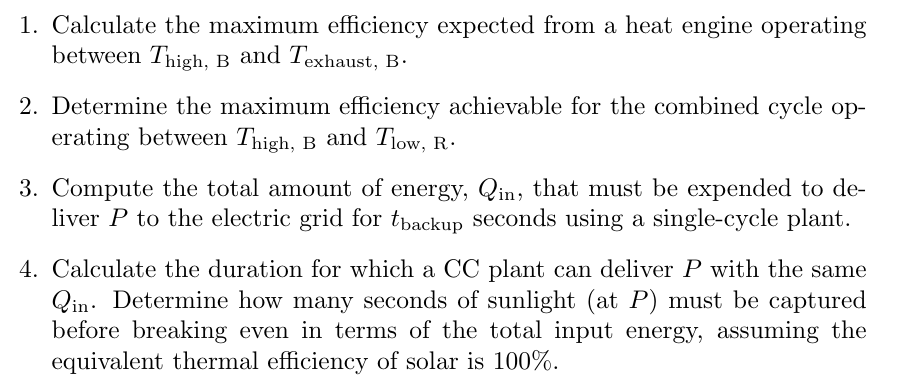
3) Combined Cycle (CC) Natural Gas Power: Cheap natural gas (mostly from
fracking and similar extraction techniques) and CC gas plants are one of the
primary reasons that US carbon emissions peaked in ∼2010 and has been declining. Here, natural gas powers a Brayton cycle turbine, and the exhaust
from that turbine is then fed into a steam generator to run a Rankine cycle
turbine.
a) The high temperature in the Brayton cycle turbine is 1500K. The exhaust for the Brayton
cycle exits at about 850K. What is the maximum efficiency that you could expect from a
heat engine operating between these two temperature extremes?
b) A heat exchanger is able to deliver the Brayton cycle exhaust to a Rankine (steam) cycle.
The the final outgoing temperature from this steam cycle is 325K. What is the maximum
efficiency that you could expect to achieve operating between the high temperature from
the Brayton cycle and the low temperature from the Rankine cycle? (That is, what is the
theoretical max efficiency of the combined cycle?)
c) In reality, the single-cycle Brayton plants only achieve about 33% efficiency. When the
sun doesn’t shine, solar power is backed up by single-cycle gas plants (the time required to
start a boiler to run a combined cycle plant is too long). Suppose that, in order to back
up a solar plant, you need to deliver one gigawatt (109 W) of work to the electric grid for
104
seconds (about three hours) after the sun sets using a single cycle plant. What is the
total amount of energy you must expend (Qin) to deliver this energy to the electric grid as
work?
d) The best CC gas plants achieve roughly 60% efficiency. If you were to input the same
amount of energy as used in the previous part (the same Qin) to deliver one gigawatt of
work with a CC plant, how many seconds of operation could you achieve? From this answer,
and your result from the previous question, how many seconds of sunlight (at 1GW) must
you capture before you break even in terms of the total input energy? (Assume that the
equivalent thermal efficiency of solar is 100%, which it is not.)


Step by stepSolved in 3 steps with 6 images

- The properties of this Organic Rankine Cycle are as follows: • Turbine feed: P = 24.49 bar, T = 272.19C• Turbine exhaust: P = 2 bar, T = 203C. Assume ideal gas at P = 2 bar. • The pump efficiency is 65%.• Benzene is used as the working fluid Calculate the turbine shaft work Ws,turbine (in J/mol).arrow_forward3. A 200 MW power plant operates on a simple Rankine cycle. Steam at 5.2 MPa, 400ºC expandsin a Rankine turbine to 0.036 MPa. Assume actual turbine with isentropic efficiency of 75 % forboth the compressor and expander. 3.1 Heat added in steam Generator , KW 3.2 Power loss at Turbine, KW 3.3 Actual thermal efficiency of the cycle 3.4 Mass of water in kilogram needed for an hour in the condenser if the changeof temperature for the water is 27ºFarrow_forwardIn the case of Reheat Rankine cycle I. the work output is always more than simple Rankine cycle. II. the quality of steam at the end of expansion is always less than that of simple Rankine cycle. a. land Il are false O b. Only I is true O c. Only Il is true O d. land Il are truearrow_forward
- The properties of this Organic Rankine Cycle are as follows: Turbine feed: P = 24.49 bar, T = 272.19CTurbine exhaust: P = 2 bar, T = 203C. Assume ideal gas at P = 2 bar. The pump efficiency is 65%.Benzene is used as the working fluid If the boiler heat transferred Qboiler = 53,637 J/mol, what is the thermal efficiency of the cycle?arrow_forwardAssume a basic (non-regenerative) ideal Brayton cycle where air modeled as IG with variables specific heat. The gas-turbine engine has the following operational parameters: Inlet Air Temperature:537 R Inlet Air Pressure:14.696 psia Compressor Pressure Ratio (rp):6.0 Firing Temperature:2400 R Heat Recovery Steam Generator: Assume that the exhaust from the gas turbine engine is directed to a heat recovery steam generator (HRSG)to produce wet steam (i.e. saturated vapor) at a pressure of 600 psia. Liquid water is supplied to the HRSG at 100F and 600 psia. The exhaust gas from the gas-turbine engine leaves the HRSG at the saturation temperature of the wet steam. With these conditions determine: a) the exit temperature of the wet steam (F), b) the intensive steam production rate, lbm-steam/lbm-exhaust gas. Absorption Chiller CHP: Assume the process steam from the HRSG is now used to drive an absorption chiller with COP of 0.7, and that the mechanical power of the gas-turbine engine is used…arrow_forward
 Elements Of ElectromagneticsMechanical EngineeringISBN:9780190698614Author:Sadiku, Matthew N. O.Publisher:Oxford University Press
Elements Of ElectromagneticsMechanical EngineeringISBN:9780190698614Author:Sadiku, Matthew N. O.Publisher:Oxford University Press Mechanics of Materials (10th Edition)Mechanical EngineeringISBN:9780134319650Author:Russell C. HibbelerPublisher:PEARSON
Mechanics of Materials (10th Edition)Mechanical EngineeringISBN:9780134319650Author:Russell C. HibbelerPublisher:PEARSON Thermodynamics: An Engineering ApproachMechanical EngineeringISBN:9781259822674Author:Yunus A. Cengel Dr., Michael A. BolesPublisher:McGraw-Hill Education
Thermodynamics: An Engineering ApproachMechanical EngineeringISBN:9781259822674Author:Yunus A. Cengel Dr., Michael A. BolesPublisher:McGraw-Hill Education Control Systems EngineeringMechanical EngineeringISBN:9781118170519Author:Norman S. NisePublisher:WILEY
Control Systems EngineeringMechanical EngineeringISBN:9781118170519Author:Norman S. NisePublisher:WILEY Mechanics of Materials (MindTap Course List)Mechanical EngineeringISBN:9781337093347Author:Barry J. Goodno, James M. GerePublisher:Cengage Learning
Mechanics of Materials (MindTap Course List)Mechanical EngineeringISBN:9781337093347Author:Barry J. Goodno, James M. GerePublisher:Cengage Learning Engineering Mechanics: StaticsMechanical EngineeringISBN:9781118807330Author:James L. Meriam, L. G. Kraige, J. N. BoltonPublisher:WILEY
Engineering Mechanics: StaticsMechanical EngineeringISBN:9781118807330Author:James L. Meriam, L. G. Kraige, J. N. BoltonPublisher:WILEY





